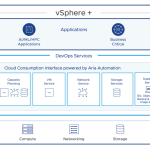When you think of VMware, virtualization clearly jumps to mind. But if you take a step back, virtualization is really a means to an end. IT pros don’t earn their salary because they run virtual machines — but VMs support application services that are essential to business, ultimately contributing to the bottom line. VMware is focused on providing the best place to run any application; from LAMP stacks to business-critical workloads to big data analytics, vSphere can handle it all.

Two open source projects were just announced by the Cloud-Native Apps group: Project Photon and Project Lightwave. Both of these projects will be foundational elements for running Linux containers and supporting next-generation application architectures. This marked a big milestone in the lifecycle of VMware Cloud-Native Apps, and at first glance may seem to be a lot more relevant to application developers than the traditional vSphere audience, but there really is a great tie-in to the Software-Defined Data Center.
If you’re a vSphere administrator, an important part of your role is supporting the developers that create the apps that run on your infrastructure. There is a shift underway with developers right now – moving from a traditional waterfall model to agile, continuous integration. For a specific example of the change in mindset from previous software development processes, check out The Twelve-Factor App to see why the container enthusiasm starts to really make sense.
Today, customers trust their Software-Designed Data Center based on VMware infrastructure for any app. It would be a shame if a new platform for applications came along and brought back the silos of yesteryear. This is why vSphere admins should care about next-generation applications and corresponding infrastructure. The container runtime becomes another essential component of the infrastructure and it should be integrated for seamless operation. With Photon, VMware is going to make it easy to run containers alongside all of the other workloads – no silos here!
Photon is going to be available in places where developers expect to find it. For example, many developers use HashiCorp Vagrant as an easy means of pulling down standardized VM images from a central repository. A Photon image will be available there and elsewhere, enabling the same container runtime on laptops, in the datacenter, and in public clouds.
Administrators will like the fact that Photon has a small footprint because it is not weighed down with all of the packages typically found on a Linux system, and one can draw parallels with the VMware ESXi thin hypervisor. Less is more when it comes to infrastructure – fewer patches, less administration, and improved SLAs are among the key benefits.
The companion open source project – Lightwave – is an authorization and authentication platform with origins from the vSphere platform. It provides multi-master replication for scalable HA and flexible topology choices to accommodate any architecture.
There is great integration between Lightwave and Photon. In fact, Lightwave is designed to actually run directly on Photon instances – no general-purpose OS needed. Take a look at this demo video where a new Lightwave domain is created, Photon clients are joined to the domain, and ssh logins are authenticated against directory credentials, eliminating the need to manage local user accounts.
Linux containers are all the rage right now, but it’s not a zero-sum proposition. Containers run great on vSphere and VMware is investing accordingly. VMware SDDC administrators can be confident that their platform is, and will be, the best for any application – with the security, manageability, and governance that enterprises need.













